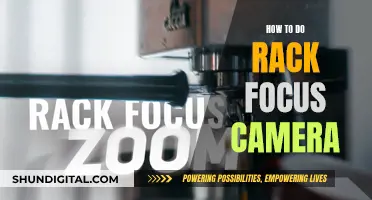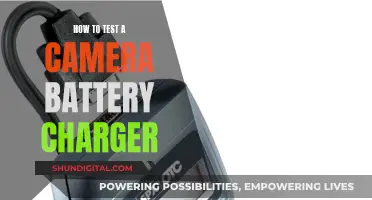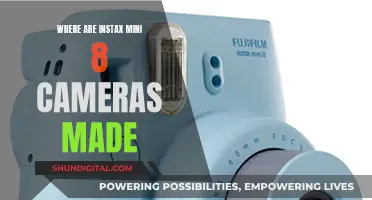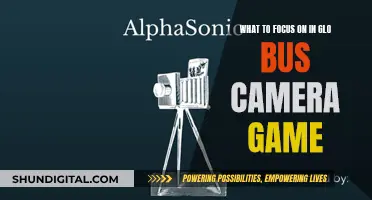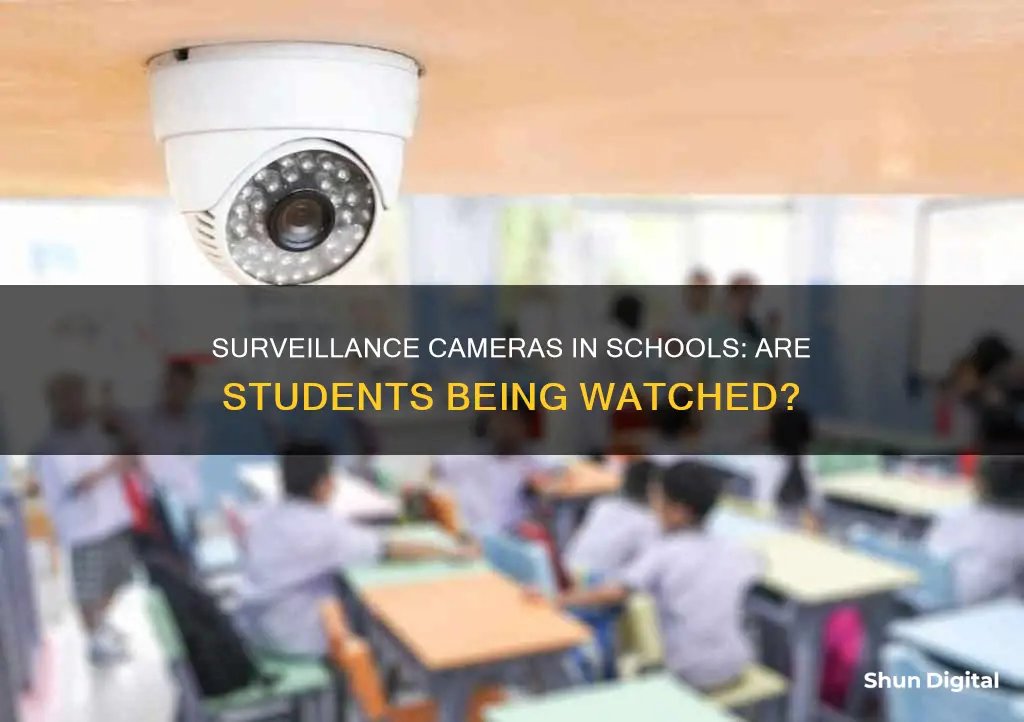
The use of surveillance cameras in schools is a highly debated topic. While some argue that it is an invasion of privacy, others claim that it is necessary to ensure the safety and security of students and staff. Surveillance cameras in schools can help deter criminal activity, monitor student behaviour, and improve emergency response. Additionally, they can provide evidence in cases of bullying, assault, or false accusations. However, the presence of cameras may also create a feeling of alienation and mistrust among students and staff, and there are concerns about the financial costs and maintenance of such systems. The effectiveness of surveillance cameras in schools is a complex issue that requires careful consideration of the benefits and drawbacks.
| Characteristics | Values |
|---|---|
| Surveillance in schools | 91% of public schools in 2019-2020 |
| Surveillance in UK schools | 85% of schools |
| Surveillance in Australian schools | Many schools have cameras in playgrounds and carparks |
| Surveillance in Delhi schools | The Chief Minister announced the installation of security cameras in all public schools |
| Surveillance in English schools | 99% of state-run schools have CCTV systems |
| Reasons for surveillance | Safety, security, prevention of crime, monitoring of students and staff, prevention of unauthorised access, etc. |
| Types of cameras | On-premise (NVR) systems, cloud video surveillance systems, bullet, dome, PTZ, fisheye, etc. |
What You'll Learn

Safety and security
The safety of students and staff is a top priority for schools. In recent years, there has been a growing concern from all education stakeholders regarding the safety of individuals in schools. There have been allegations of staff and students being targeted with violence and bullying by their peers, parents, and colleagues. With the rise in bullying and gun violence, it is crucial to strengthen school security systems.
Video surveillance is an effective tool to enhance campus safety and address these concerns. Security cameras act as a deterrent for potential crimes, including theft, mischief, vandalism, and car theft. They also help in monitoring and reducing bullying, creating a safer environment for students and staff. Additionally, cameras can be placed at main entrances and exits, busy corridors, and off-limit areas to keep an eye on the entire campus in real time.
In the unfortunate event of an emergency, video surveillance improves response by providing reliable, up-to-date information. It enables schools to respond to incidents more quickly and share live footage with emergency responders. This real-time visibility is crucial in emergency situations, such as active shooter scenarios, and helps in accelerating emergency response and evacuation procedures, ultimately saving lives.
Another benefit of security cameras is their ability to control campus perimeters and building access. By detecting unauthorized visitors and monitoring students and staff, security staff can better ensure the safety of those on campus. This is especially important during school hours when the likelihood of incidents, crime, and violence increases due to the higher number of individuals present.
Furthermore, video surveillance can be advantageous in holding both students and teachers accountable for their behavior. For students, it can be used to address misconduct and bullying, while for teachers, it can provide evidence against false accusations of misconduct. This two-way accountability fosters trust between parents and the school, as parents can feel confident that their children are safe and that any issues will be promptly addressed.
However, it is important to consider the potential drawbacks of video surveillance in schools. One of the main concerns is privacy. While it is essential to ensure the safety of students and staff, invading their privacy can create a hostile environment and a sense of alienation. It is crucial to strike a balance by avoiding placing cameras in areas where privacy is required, such as restrooms and locker rooms.
Additionally, the cost of implementing and maintaining security camera systems can be significant. Schools need to carefully evaluate their budgets and explore options like grants and special discounts to make video surveillance a feasible option.
Overall, video surveillance in schools can significantly enhance safety and security. By deterring crimes, reducing bullying, improving emergency response, and holding individuals accountable, schools can create a safer and more secure environment for students, staff, and the entire school community.
Updating Adobe Camera Raw: A Step-by-Step Guide
You may want to see also

Privacy concerns
The use of surveillance cameras in schools raises several privacy concerns. Firstly, there is a risk of privacy invasion as students, staff, and parents may feel that their privacy is being invaded if cameras are installed irresponsibly or without their knowledge. It is important to ensure that cameras are placed in appropriate locations, excluding private spaces such as restrooms, locker rooms, and employee lounges. Schools should also develop clear policies around video surveillance and ensure that all stakeholders are informed and educated about the purpose and use of the cameras.
Secondly, the use of surveillance cameras in schools can create a sense of mistrust and apprehension among teachers and students. They may feel that they are being constantly monitored and that the school does not trust them. It is crucial to address these concerns by communicating the purpose of the cameras, which is to enhance the safety and security of the school community. Additionally, providing teachers and students with access to footage and involving them in the decision-making process can help alleviate these feelings of mistrust.
Thirdly, the presence of surveillance cameras in schools may impact academic achievement and create a hostile environment. Some students may feel alienated by the constant surveillance, leading to a negative view of the school environment. It is important to strike a balance between security measures and creating a positive and welcoming school atmosphere. Additionally, the use of cameras in classrooms may not be the most effective approach, as violence and disciplinary issues often occur in hallways, bathrooms, and stairwells. Therefore, schools should carefully consider the placement of cameras to address safety concerns without hindering the educational experience.
Lastly, the cost of installing and maintaining surveillance camera systems can be significant. Schools, especially those with limited resources, may struggle to afford the initial investment and ongoing maintenance costs. However, there are options available, such as grants and special discounts, to help schools obtain these systems without straining their budgets.
iPad Camera: What Materials Make It?
You may want to see also

Cost of installation
The cost of installing surveillance cameras in schools can vary depending on several factors, including the number of cameras, the type of camera, the labor involved, and any additional features or equipment required. Here is a breakdown of the costs associated with installing surveillance cameras in schools:
Cost of Cameras
The cost of security cameras can range from $20 to $250 per camera, excluding labor. The price depends on the camera's resolution, features, and whether it is designed for indoor or outdoor use. Outdoor cameras typically cost more due to their higher resolution, wider field of view, and increased installation difficulty.
Installation Labor
The labor cost for installing security cameras is usually the most significant expense in the overall budget. Installation charges can range from $80 to $200 per camera, depending on the type of camera and the complexity of the installation. Wired cameras, such as CCTV or IP cameras, tend to be more expensive to install than wireless cameras.
Additional Equipment and Features
Surveillance camera systems may require additional equipment and features, which can add to the overall cost. This includes items such as hard drive storage for footage, surveillance system software, motion detection sensors, and remote monitoring services. These additional features can range from $20 to several hundred dollars, depending on the specific needs of the school.
Total System Cost
The total cost of installing a surveillance camera system in a school will depend on the number of cameras, the type of cameras chosen, and the complexity of the installation. For a basic system with four cameras, the cost can range from $500 to $2,000. More extensive camera setups with eight or more cameras can cost $3,500 or more.
Cost Comparison with Other Security Measures
It is worth noting that the cost of installing surveillance cameras should be compared with the cost of other security measures that schools may consider. For example, metal detectors, alarm systems, and security personnel are all options that schools may explore to enhance security. The effectiveness and cost-benefit analysis of different security measures should be carefully evaluated before making a decision.
In conclusion, the cost of installing surveillance cameras in schools can vary significantly depending on the specific needs and requirements of the institution. Schools should carefully consider their security needs, budget constraints, and the potential benefits of surveillance cameras before making a decision.
Simplisafe Doorbell Camera: Battery or Wired?
You may want to see also

Teacher accountability
The use of surveillance cameras in schools is a highly debated topic. While some people argue that it is an invasion of privacy, others believe that it is necessary for safety and security reasons. Video surveillance in schools can be a valuable tool for enhancing campus safety, improving emergency preparedness, deterring crimes, and preventing bullying. However, it is essential to consider the potential drawbacks, such as privacy concerns, financial constraints, and mistrust from teachers and students.
Preventing Harassment and False Accusations:
Surveillance cameras can help prevent and address instances of harassment and false accusations involving teachers and students. In recent years, there has been an increase in concerns over the safety of individuals in schools, with allegations of staff being targeted by students, parents, or colleagues, and vice versa. Surveillance cameras provide objective evidence in cases of harassment or assault, helping school administrators take appropriate action. This not only protects students from potential harm but also safeguards teachers from false accusations, thus ensuring teacher accountability and maintaining a safe learning environment.
Monitoring Teacher Performance:
Surveillance cameras can be used to monitor teacher performance and ensure they are fulfilling their duties effectively. For example, administrators can remotely observe classes and gain valuable insights without disrupting lessons. This allows for a more accurate evaluation of teacher performance and can help identify areas where additional support or professional development may be needed.
Emergency Preparedness and Response:
Surveillance cameras can be instrumental in emergency situations. They provide real-time alerts and recorded video footage, enabling school administrators and emergency responders to assess the situation promptly and take swift action. This not only ensures the safety of students and staff but also allows for a more efficient evacuation and security of the school premises.
Deterring Rule-Breaking and Illicit Behaviors:
The presence of surveillance cameras can deter teachers and students from engaging in rule-breaking or illicit behaviors. Cameras placed in strategic locations, such as classrooms, hallways, and common areas, can help monitor and discourage inappropriate behavior, substance use, or any other activities that may violate school policies.
Facilitating Incident Resolution:
In the event of disputes, incidents of misconduct, or criminal activities involving teachers, surveillance footage can provide clear evidence to aid in investigations. This helps school administrators, local law enforcement, and other relevant authorities in resolving issues promptly and fairly, ensuring teacher accountability and maintaining the integrity of the educational institution.
While surveillance cameras can enhance teacher accountability, it is essential to respect privacy and adhere to legal regulations. Schools should develop comprehensive video surveillance policies that address camera placement, notification requirements, access control measures, and data retention practices. Additionally, clear communication with teachers, students, and parents about the purpose and use of surveillance cameras can help alleviate concerns and build trust.
The Exclusive Club of 50th Anniversary Camaros
You may want to see also

Student behaviour
The presence of security cameras in schools has been shown to reduce instances of bullying. When CCTV cameras were introduced to a high school in Sydney, there was a 70% reduction in bullying. In another example, Doonside Technology High School in Sydney reported a 70% reduction in bullying since installing 57 cameras. Security cameras can also be used to hold students accountable for their behaviour and can provide evidence for classroom misconduct and instances of bullying.
Video surveillance can also deter rule-breaking and illicit behaviours by students on school grounds. Cameras can be placed in parking lots, around intramural fields, and in other places where people might gather. In the event that an incident does occur, the footage can be used to take action.
However, some students who have experienced cameras in the classroom have reported feeling a lack of trust between the school and themselves. It has also been suggested that the presence of security cameras in schools may create a feeling of alienation for some students and can incite a negative view of the school environment.
In addition, there is a concern that the use of security cameras in schools may be an invasion of privacy. This is particularly relevant if cameras are installed irresponsibly, such as using hidden cameras or placing them in areas where privacy is required, such as restrooms and locker rooms.
Speeding Tickets: Insurance Premiums and Camera Fines Explained
You may want to see also
Frequently asked questions
Surveillance cameras in schools can improve emergency preparedness and response, deter theft, mischief, vandalism, car theft, and potential threats, decrease bullying, and help control campus perimeters and building access.
Surveillance cameras in schools can create a feeling of alienation for some students and incite a negative view of the school environment. They can also be expensive to install and maintain, and there may be concerns about privacy invasion.
Schools use either on-premise (NVR) systems or cloud video surveillance systems. Camera form factors include bullet, dome, PTZ, and fisheye.
Surveillance cameras are typically placed in busy corridors, off-limit areas, main entrances and exits, and other areas where people tend to gather, such as parking lots and intramural fields.


